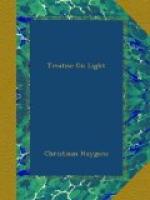I shall therefore essay in this book, to give, in accordance with the principles accepted in the Philosophy of the present day, some clearer and more probable reasons, firstly of these properties of light propagated rectilinearly; secondly of light which is reflected on meeting other bodies. Then I shall explain the phenomena of those rays which are said to suffer refraction on passing through transparent bodies of different sorts; and in this part I shall also explain the effects of the refraction of the air by the different densities of the Atmosphere.
Thereafter I shall examine the causes of the strange refraction of a certain kind of Crystal which is brought from Iceland. And finally I shall treat of the various shapes of transparent and reflecting bodies by which rays are collected at a point or are turned aside in various ways. From this it will be seen with what facility, following our new Theory, we find not only the Ellipses, Hyperbolas, and other curves which Mr. Des Cartes has ingeniously invented for this purpose; but also those which the surface of a glass lens ought to possess when its other surface is given as spherical or plane, or of any other figure that may be.
It is inconceivable to doubt that light consists in the motion of some sort of matter. For whether one considers its production, one sees that here upon the Earth it is chiefly engendered by fire and flame which contain without doubt bodies that are in rapid motion, since they dissolve and melt many other bodies, even the most solid; or whether one considers its effects, one sees that when light is collected, as by concave mirrors, it has the property of burning as a fire does, that is to say it disunites the particles of bodies. This is assuredly the mark of motion, at least in the true Philosophy, in which one conceives the causes of all natural effects in terms of mechanical motions. This, in my opinion, we must necessarily do, or else renounce all hopes of ever comprehending anything in Physics.
And as, according to this Philosophy, one holds as certain that the sensation of sight is excited only by the impression of some movement of a kind of matter which acts on the nerves at the back of our eyes, there is here yet one reason more for believing that light consists in a movement of the matter which exists between us and the luminous body.




